Euthrix potatoria
Euthrix potatoria, the drinker, is an orange-brown moth of the family Lasiocampidae.[1]
| Drinker | |
|---|---|
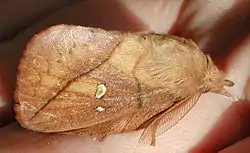 | |
| Euthrix potatoria. Male | |
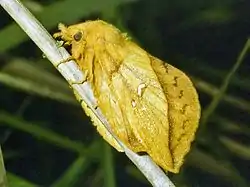 | |
| Female | |
| Scientific classification | |
| Kingdom: | |
| Phylum: | |
| Class: | |
| Order: | |
| Family: | |
| Genus: | |
| Species: | E. potatoria |
| Binomial name | |
| Euthrix potatoria | |
| Synonyms | |
| |
The species' common and scientific names derive from the larva's supposed drinking of drops of dew.[2]
Name
The scientific name Euthryx potatoria was given to this moth by Carl Linnaeus in 1758. In choosing the name potatoria ‘drinker-like’, he was inspired by the Dutch entomologist Johannes Goedaert, who had called the animal dronckaerdt ‘drunkard’ “because it is very much inclined to drinking”.[3] This remark refers to the moth’s habit of repeatedly plunging its head into the water.[4] The English name drinker (moth) also refers to Goedaert’s analogy.
Subspecies
Subspecies include:[1]
- Euthrix potatoria mikado Bryk
- Euthrix potatoria potatoria (Linnaeus, 1758)
Distribution and habitat
This species can be found in Europe.[5] The species is fairly common in the southern half of Britain. In Scotland, it is common in the west but not in the east of the country. It is most frequently found in marshy places, fens and riversides but may also be seen in drier, grassy terrain.[6][7]
Status
In a recent survey to determine the status of all macro moths in Britain this species was classified as common.
Description
Imago
The imago has a wingspan of 45–65 mm. The yellowish females are slightly larger than the orange-brown male but both sexes usually show the two distinctive white spots on the forewing.[7] Females have slightly serrated antennae, while male have deeply combed antennae.[8]
Larvae and pupae
The fully grown larva is about 6 cm long, hairy, striped and spotted, with distinctive tufts fore and aft. Larvae hibernate while young and resume feeding in the spring, pupating in a cocoon during the summer.[6]
Biology
This nocturnal moth flies from June to August depending on the location. Males especially are attracted to light.[6][7] The females lay their eggs in small clusters, mainly on the stem of grasses or reeds.[8] The larvae feed on various grasses and reeds (Alopecurus, Deschampsia, Dactylis, Elytrigia, Carex, Luzula and other Gramineae).[9]
Gallery
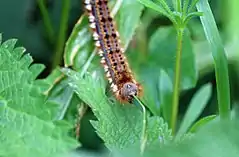 Drinker moth caterpillar eating grass.
Drinker moth caterpillar eating grass.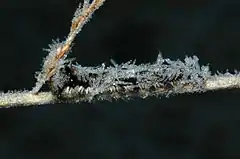 Hibernating larva
Hibernating larva.jpg.webp) Caterpillar
Caterpillar_underside.jpg.webp) Caterpillar (ventral)
Caterpillar (ventral)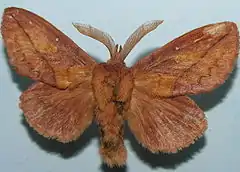 Mounted specimen. Male
Mounted specimen. Male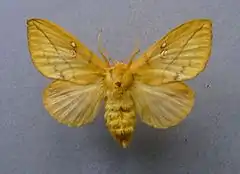 Female
Female
References
- Biolib
- "The Drinker Euthrix potatoria". UK Moths. Retrieved 18 June 2014.
- Goedaert, J. (1660), Metamorphosis naturalis. Middelburgh: Jaques Fierens (p. 47).
- Beelen, H., & Van der Sijs, N. (2018). Natneus, molenaar, hypocriet. Insectennamen uit de zeventiende eeuw. Onze Taal, 2018(7/8), 26-27.
- Fauna europaea
- Ford, R.L.E. (1963). Larger British Moths. Frederick Warne.
- UK Moths
- Insight.com/drinker-moth-euthrix-potatoria-bf-1640/ Wildliifeinsight
- Paolo Mazzei, Daniel Morel, Raniero Panfili Moths and Butterflies of Europe and North Africa
External links
| Wikimedia Commons has media related to Euthrix potatoria. |